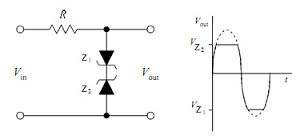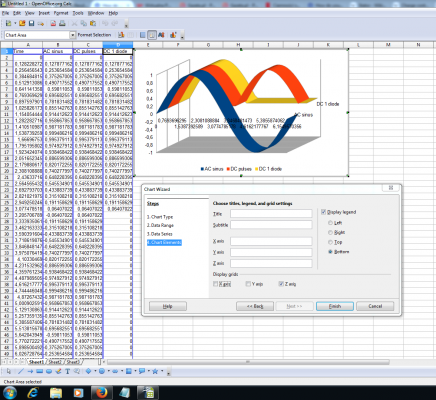-
Posts
7927 -
Joined
-
Last visited
-
Days Won
26
Content Type
Profiles
Forums
Events
Everything posted by Sensei
-

Important experiment request: Distant single photon
Sensei replied to Theoretical's topic in Speculations
These details physicists learned most likely on studies.. So obviousness to scientists are skipped in PDF, to not bore reader. How about starting from learning everything from beginning.. ? It's not a problem making f.e. particle detector. Making your own Cloud Chamber costs $20. Device making couple millions volts you can have below $200. Device making x-rays you can have for $30 (Cockcroft-Walton generator). But you will need to build your own vacuum pump or buy one. It's a matter of how much serious you want to be in your science discovery. How much you want to spend money and time on it. ps. I can give you link to must-have devices for physicists in PM (where you could buy them). -

Important experiment request: Distant single photon
Sensei replied to Theoretical's topic in Speculations
Do you know how to make x-rays.. ? Lacking in detail: because it's too much data. And you most likely don't know it. f.e. for every isotope (there is 3142 unstable/stable isotopes of 118 elements), there is needed different energy of photon to disintegrate. f.e. to disintegrate Deuterium there is needed 2.22 MeV energy. Scientists use highly accelerated alpha particle to hit Deuterium, so it'll split to free proton and free neutron. Neutron is then used for other experiments. f.e. Neutron scattering. Neutron capture. https://en.wikipedia.org/wiki/Neutron_scattering https://en.wikipedia.org/wiki/Neutron_capture -

Important experiment request: Distant single photon
Sensei replied to Theoretical's topic in Speculations
How about photon-matter interactions, as showed in this video? Keywords for Google: photoelectric effect, Compton scattering, electron-positron annihilation, pair production, photodisintegration. -
Ionization of whatever you punched and thing that was used for punching, if more energy is used, then disintegration of atoms, they would separate to protons, neutrons, alpha particles, etc. f.e. to disintegrate Deuterium atom there is needed 2.22 MeV energy per nucleus. Actually it happens all the time in the atmosphere, at quantum level, highly accelerated incoming cosmic ray is hitting particle of air, or anything on the ground, and devastating it. Lucky, it's pretty low quantity. Otherwise there would be no living organisms (destruction of DNA chain, destruction of cells).
-

Important experiment request: Distant single photon
Sensei replied to Theoretical's topic in Speculations
My LEDs AFAIK have 20-25 mA at full bright. But let's it be 2 mA. It's still something like: 1.25*10^16 photons per second (idealized, assuming no lost).. How far do you want to go from it, if you have 1.25*10^16 photons emitted from LED per second? Do you know inverse-square law? (light from star, lightbulb etc.) If we apply inverse-square law to such quantity of photons per second, we have 1 photon per m2 of area per second, at distance equal to 31.5 millions meters from source.. -
I fail to see how air ionization by laser, or doubling/tripling frequency are examples of overlapping photons.. After absorbing the first photon, excitation of electron in atom, takes some time. If yet another second photon excite it even further, before it go back to ground state, electron will reach higher energy level, and release even more energetic photon. Send beam of photons with E=10.2 eV (n=1 -> n=2) to Hydrogen, then another beam of photons with E=1.8889 eV (n=2 -> n=3), and you will get as a result photons with E=12.09 eV (n=3 -> n=1).. Laser used to ionization is generating exclusively polarized photons.. ? If two or more photons have different polarizations, then IMHO they don't overlap.
-

How do you reduce voltage and make a current last longer?
Sensei replied to MWresearch's topic in Engineering
I am not too much experienced with alternators, but in normal electric motors, the faster spinning, the higher voltage. So if it's exactly the same with alternators, which is what I suppose so. Spinning too fast (if there is nothing like regulator), could cause damage of electronics connected directly to it, in certain extreme situations. (Google shows plentiful of pages after searching for "alternator producing too much voltage", so it's real issue). In such situations, voltage threshold triggered branch with zener diodes could be used, f.e. Place fuse in horizontal branch instead of resistor. Zener diodes f.e. 15 V. If voltage is exceeding 15 V, current will flow through zener branch, instead of normal branch, and fuse will blow up, disconnecting entire circuit. Such (or other) security elements should be used in circuits, regardless whether current/voltage regulators are present. They might fail, and you need to be prepared for it in advance. Single zener diode costs here $0.05. -

How do you reduce voltage and make a current last longer?
Sensei replied to MWresearch's topic in Engineering
See screen-shot, blue curve is initial input: blue = sin(time) So it's like AC. red curve is: red = abs( blue ) So it's like AC rectified to DC by 4 diodes/rectifying bridge. yellow curve is: yellow = max( blue, 0 ) So it's like AC rectified to DC by 1 diode. Source of AC, is pretty meaningless. Whether it's mains, or alternator, or electric motor spinning once in one direction, then other, theory works the same. -

How do you reduce voltage and make a current last longer?
Sensei replied to MWresearch's topic in Engineering
Do you know OpenOffice? I attached project for calculator/excel. You can load and see difference between AC, DC pulses (output from rectifying bridge, or four diodes), DC rectified by 1 diode. Did you checked it in the real world experiment? Normally electric motors create DC while spinning one direction. Especially toy electric motors. You need 1 diode to do max(sin(t),0) (cut negative part of wave) and you need 4 diodes to do abs(sin(t)). That's how I draw graph in OpenOffice project. For normal single phase AC, 1 or 4 diodes are needed, no more, no less. No. If source of movement is changing direction of spinning motor, it'll be pulsating AC. If source of movement (whatever it is) just one direction, it'll be pulsing DC. And amount of pulse will depend on speed of spinning.AC DC DC pulses.zip -

How do you reduce voltage and make a current last longer?
Sensei replied to MWresearch's topic in Engineering
I will give you +1 for seeking for knowledge.. All this is easy to see if you have oscilloscope and toy electric motor. Do you have? Connect electric motor directly to oscilloscope (because it shows past values on graph), or multimeter (it'll be harder). And start spinning it manually. You should see voltage is f.e. +some value on graph or display of multimeter. Then start spinning it opposite. You should see voltage is -some value. How large is this value depends on how fast you're spinning it by hand. source of energy is in this case spinning rotor of electric motor, so treat is as any other source of power. Attach it to rectifying bridge, and on output from bridge there will be pulsing DC. You would need four diodes, or one rectifying bridge. I am confused by your questions here. In showed by me design of electric motor, magnets are is stationary stator, and wires are around iron cores (electromagnet) in rotating rotor. It's not just one design of electric motor. It can be swapped (magnets in rotor, electromagnets in stator). It can have different quantity of magnets/electromagnets. It can be plain wire, without iron core. Why are you starting talking about charge regulators? When we're talking about electric motors. Not sure. Charge regulator https://en.wikipedia.org/wiki/Charge_controller "Simple charge controllers stop charging a battery when they exceed a set high voltage level, and re-enable charging when battery voltage drops back below that level." Such large quantity of pulses per second are almost only in electronic oscillators https://en.wikipedia.org/wiki/Electronic_oscillator Smoothing is needed to not constantly switch on/off whatever is using our generator. f.e. typical lightbulb is pulsing 100 per second, as it runs entirely on AC 50 Hz (50 Hz AC = 100 Hz pulses). This can be seen after recording at high rate camera (even 120 FPS recording is sufficient). Devices requiring steady DC current (electronics) wouldn't like it. -
Imagine body with temperature. It's emitting photons in the all directions, using inverse square law https://en.wikipedia.org/wiki/Inverse-square_law The higher temperature, the more energy have emitted photons. Bodies with low temperature are emitting photons in infrared, or microwave spectrum. Hot bodies such as stars are emitting photons in visible spectrum. These photons are absorbed by neighbourhood particles of gas, liquids, solids, and heating them. These gases, liquids and solids also emits their own photons to environment (otherwise their temperature and energy would be going to infinity, and they would be changing state, melting, vaporizing, ionizing. Radiation is a way to release too much energy in them). If emission meets absorption there is subtle equilibrium. Bodies heated in day (from Sun), will release accumulated energy at night time. If next day is not sunny, they'll receive little energy, and won't emit more than they have. We can use infra red cameras (expensive), or infra red thermometers (cheap), to learn body temperature from distance. They analyze spectrum of photons emitted by body to calculate temperature (typically invisible spectrum) to show on display (or make array of them width x height in camera case).
-
704 million years is half-life time. It's time needed to decay half of Uranium-235 isotope to it's daughter isotope. https://en.wikipedia.org/wiki/Decay_product Daugther isotope depends on decay mode. In case of Uranium-235, it's alpha decay, that's it, atomic number is decreased by 2, and mass number is decreased by 4 (or neutron number is decreased by 2). Z=92-2 = 90 protons. A=235-4 = 231 mass number. Isotope with Z=90,A=231 is Thorium-231. Giving overall reaction: U-235 -> Th-231 + alpha particle + 4.679 MeV energy released. Thorium-231 has plentiful of mass, approximately 231.0363043 u. So if you have 235 grams of U-235, after 704 million years you will have 235*0.5 = 117.5 grams of U-235, and 231*0.5 = 115.5 grams of Th-231. 117.5 + 115.5 = 233 grams. But because Th-231 is very unstable, it's also approximation, as it'll decay already within couple hours after making it.
-

How do you reduce voltage and make a current last longer?
Sensei replied to MWresearch's topic in Engineering
Rectifying diode is passing current one way, and blocking the other way (if it's not broken). Rectifying bridge (or four rectifying diodes) is turning sinusoid AC wave, to pulses in one direction current. Smoothing capacitor(s) will smooth these pulses to something more resembling flat DC. Electric motor is typically three or more electromagnets, and same quantity magnets. Not just one. Current passes through 1st electromagnet (wire+iron core f.e.), and creates magnetic field. This field is repelling from stationary magnet (polarization f.e. N on electromagnet and N on magnet). And rotor is spinning to 2nd position. Electromagnet is disconnecting from external power wires. After spin, 2nd electromagnet is connecting to these wires, powered up, and again repelling, and it's going in circle. Here you have example three electromagnet rotor: This one has 15-16 Also there is induction in ferromagnetic cores of electromagnets. If you connect DC to motor one way (+ to +, - to -), it'll be spinning in one direction f.e. clockwise, after swapping polarization of DC (+ to -, - to +), it'll be spinning in opposite direction. anti clockwise. After connecting AC to motor, it'll be spinning in one direction for some time (typically very short), and in other for some time. With high frequency AC, it'll be invisible spinning. Switching f.e. 50 Hz is so fast, rotor appears still. But you won't be able to spin it by hand. It will have great resistance for any manual spinning (unlike when power is turned off). -
It should be something like: <?php $string = $_GET[ 'data' ]; $result = Add( $string ); printf( "Result %d<br />\n", $result ); exit; function Add( $string ) { $result = 0; [... here you put all your code...] return( $result ); } ?> Replace contents of Add() by your code. Then test it, by going web browser to index.php?data=[string]
-
If you have // at beginning, the first whole row is delimiter definition. The rest is "string". So make if string is starting with // then find the first \n, and it's whole delimiter definition, after \n there is "2nd part". Then remove // and split the rest by finding brackets [....] (split using reg exp! They will probably test your knowledge in this area) where .... is our delimiter. After that, if delimiter definition was f.e. //[x][y][z]\n There will be array of x y z Whatever they are. what? Do you even know PHP? isset() is testing variable of PHP.. f.e. You have index.php?xyz=123 $_GET[ 'xyz' ] contains 123 if( isset( $_GET[ 'xyz' ] ) ) will return true. After using index.php (no params) it'll return false.
-
You made it impossible They didn't think about the case if delimiter is digit. Delimiter is whatever is in string (optionally). String with delimiter "*1*" (3 chars delimiter) and such digits later should throw exception, because delimiter can't be at first char.. It's like you would have ",3,2" (with default , delimiter) This is actually easy task. 1) find whether you have redefined delimeters or not. Split them to 1st (delimeters) and 2nd part (data). Split delimeters to array. 2) if there are custom delimeters, replace each delimeter found in 2nd part by default delimeter f.e. ",". Use regular expressions. 3) Add numbers in 2nd part.
-
"The best" means "the fastest", or "the less needing effort/cheap".. ? Eugenol, according to net, is not soluble in water. And has higher density than water. So it should with time gather on bottom of flask. I would try simply to leave it for days/weeks alone to see what happens. Gravity will do the rest.
-
I am doing such calculations every day during purchasing and selling real stock shares. Even wrote special application in C/C++ for it. Yours must be simple excersise for school. In reality you must take into account provision from brokers and stock market. We have here 0.35% provision for buying through Internet platform, calling to human broker cost much more and depends on amount of money in transaction, there used to be 1.5%-3.5%. Not following it by myself, as I am not using call-buy, and if we sell same day, 0.2% provision for day trading, otherwise 0.35% for selling. For instance, I buy 1000 shares for 14. 14 * 1000 * ( 1 + 0.35/100 ) = 14000 * 1.0035 = 14049, giving average 14.049 per share (not plain 14, as one layman could think!) If I sell them for 14.1 the next day, stock broker will add to my account: 14.1*1000 * ( 1 - 0.35/100 ) = 14100 * 0.9965 = 14050.65, and earned will be 14050.65 - 14049 = 1.65 (so if you buy and sell for the same price, you will be on minus, because of provision) Additionally there is limit on how low can be provision (for now 5 if I recall correctly). Above example is much bigger to show this. This 0.35% is variable, and different broker house will have different price. In my old one there used to be 0.39% and minimum provision 2. But they bankrupt two, three years ago. Had to switch to different broker house.
-
Somebody tried to cover mixer by teflon to see how it works? It's widely used as non-sticking surface in other areas.
-
Yes. If you are thinking about energy coming from stars, obviously it follows inverse square law. https://en.wikipedia.org/wiki/Inverse-square_law And the largest energy will be coming from the nearest star, the nearest galaxy. On the Earth we have [latex]1367\frac{J}{s*m^2}[/latex] 100 a.u from us, it'll be [latex]0.1367\frac{J}{s*m^2}[/latex] (2.5 further than Pluto, somewhere close to aphelion of Eris)
-

How can we "identify" a non human build artifact?
Sensei replied to jeremyjr's topic in Speculations
Any Neanderthal would think I am God.. Can be greater shock than that? -

Why aren't electric cars more efficient in charging?
Sensei replied to Elite Engineer's topic in Engineering
There is something like that in Formula 1. It's used when bolide is decelerating. KERS. Kinetic energy recovery system https://en.wikipedia.org/wiki/Kinetic_energy_recovery_system While movement always with constant velocity, it can not work. But while braking, kinetic energy of car, can be collected and reused. -
Engineering: How To NOT Build Bridges.. More info http://www.rtlnieuws.nl/nieuws/binnenland/terugblik-dit-gebeurde-alphen-aan-den-rijn Good that nobody died.
-
What?! Read posts you're replying to.. I said "Just a single step from making plasma".. BTW, it's not bizzare idea. It is/was widely used technique for receiving pretty pure isotope. f.e. Manhattan Project Uranium purification. https://en.wikipedia.org/wiki/Calutron Thousands labolatories around the world that have mass spectrometers are using this technique in analyze/detection of chemical compounds they're working with.
-
Get beaker 250 mL, add 50-100 mL of 10% vinegar, and add teaspoon of baking soda, it will be so violent reaction of releasing CO2, that you will most likely have table dirty.. 50 mL 10% vinegar can give you nearly 2 Liters of CO2 gaseous. Some dissolves in water though, and bubbles will be around entire container. Too many variables. Try it by yourself at home. That depends on amount of water and power of hot plate, if you want to use it, instead of gas burner, or heating element, or alcohol lamp.. Making sodium acetate solid/hot ice is just addition to the main show of this experiment, which is just a few seconds long. Take electronic thermometer with 0-100 C scale at least. I have similar model to this -50 +300 C http://www.aliexpress.com/store/product/Digital-thermometer-Food-thermometer-Air-condtioning-thermometer-Free-shipping-Temperature-range-50-300/912708_699014153.html and you will show how temperature drops while releasing CO2.



